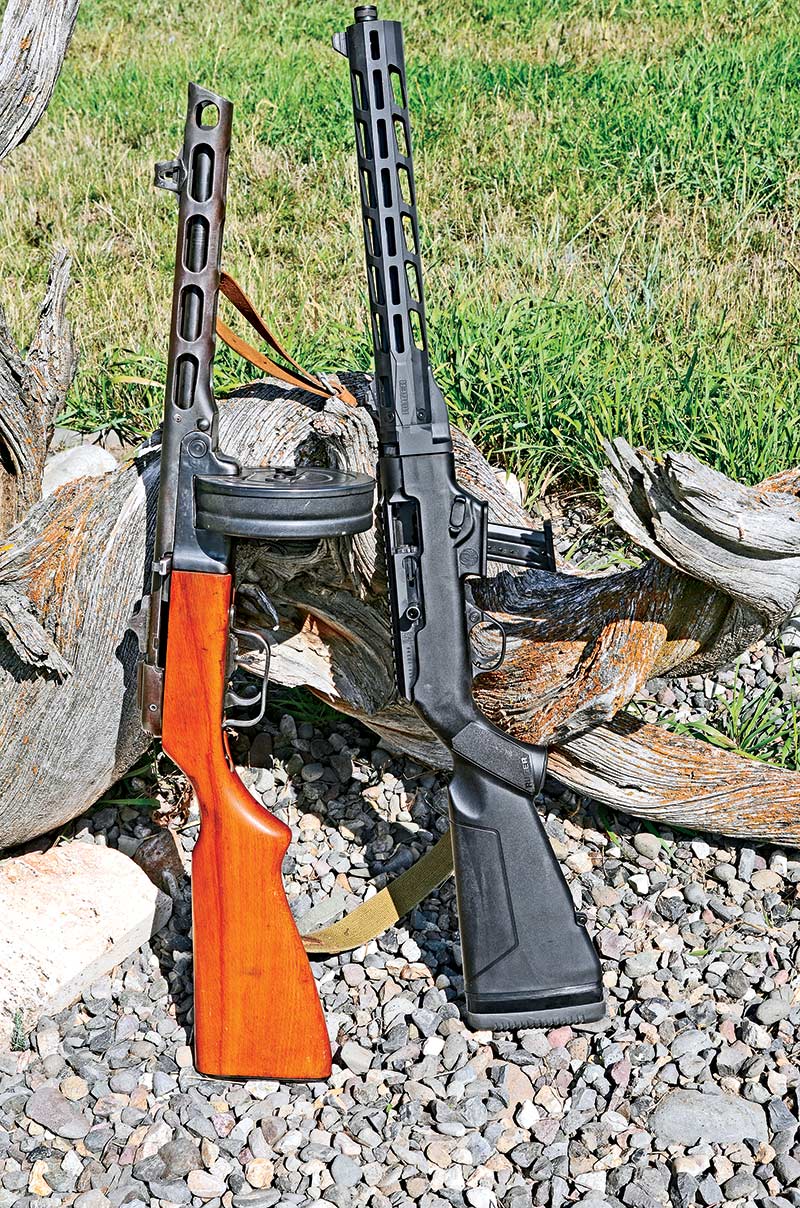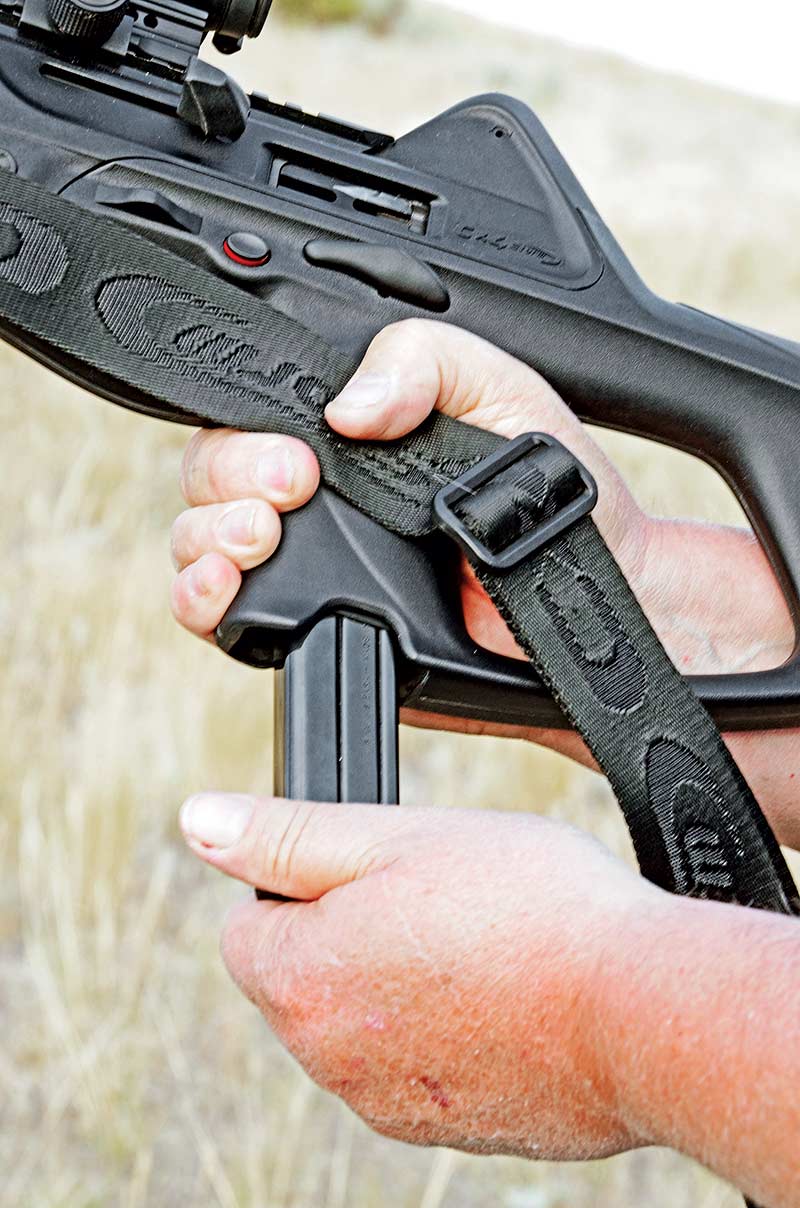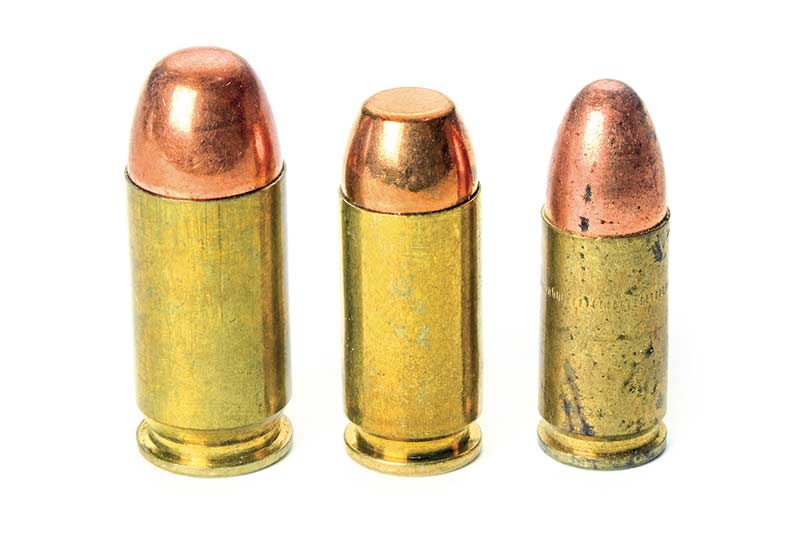Pistol Cartridge Semi-Auto Carbines
Modern And Versatile — Even Duke Likes ’Em!
In the late 1860s and early 1870s, Henrys and Winchester ’66’s (repeating rifles) became popular. Their puny .44 Henry Rimfire round was certainly weak enough to be used in fairly large revolvers. The idea carried on to .44-40’s, .38-40’s and .32-20’s. Without proof I’d say the .44-40 was top of the heap in number of revolvers and long guns so chambered.
But what about semi-auto, pistol-cartridge carbines? Matching handguns and semi-auto long guns is relatively new if you discount the .30 Carbine. Appearing in M1 Carbines in 1941, in reality the cartridge is a magnum pistol round, its case length the same as .357, .41 and .44 Magnums. The proof is in Ruger’s Blackhawk .30 Carbine revolvers that have been around for about a half-century.
Although back in the 1980s Marlin made some semi-auto carbines for pistol rounds (9mm and .45 ACP), in the 21st century there’s more impetus for pistol cartridge carbines. So many locales have made handgun ownership difficult if not actually impossible, and these short, handy rifles are a natural replacement. A carbine is the answer for someone who cannot own an actual handgun but doesn’t want excessive power — like a centerfire rifle round — in a home defense gun. For some, a shotgun is a possible choice, but for others shotgun recoil is intimidating. Pistol cartridge carbine recoil is negligible.
Good Ideas Abound
Also there’s this fact learning to shoot a handgun proficiently is a difficult task. It requires eyesight, fine motor skills, dedication, time and expense. Shooting a pistol cartridge carbine with reasonable precision, especially at handgun ranges — is easy. His Editorship Roy told me during his police career he put an early Marlin 9mm carbine into the hands of officers struggling to qualify on the range and suddenly scores jumped and anxiety levels lowered. The agency later adopted the early Ruger PC9 police carbines, which increased on-target hits in defensive shootings immediately.
Even further, some bright light at one or another gun company got the idea a semi-auto pistol cartridge carbine taking not only the same ammo but the exact same magazines as a person’s sidearm would appeal to a broad spectrum of people. That idea person was smart!
This leads me to my first experience with a pistol cartridge semi-auto carbine while visiting a friend. “What a beast!” I exclaimed. To my traditionalist’s eye his pride and joy, Beretta’s Storm (Cx4), was the ugliest gun I’d ever seen. They have black synthetic stocks formed so differently from traditional ones it took me a moment to grasp what I was seeing. I thought it was a kid’s Star Wars toy.
My friend has Storms in all three of its offered chamberings, .45 Auto, .40 S&W and 9mm Parabellum. And I’ll confess, the longer I looked at his Storms the more intrigued I was. There was plenty of practicality and innovation about them, so I borrowed them for some shooting.
Awkward?
In the beginning I found them a bit awkward since my hands and brain are used to more traditional carbines. The Storms have a large empty space behind the pistol grip. While looking odd it certainly helps keep carbine weight under six lbs. They have rails everywhere — on the top, sides and even an extendable one beneath the 16.7″ barrel. I cussed that one for not pulling out until I figured the front sling swivel must be pressed to release it. Storms come with stock extenders increasing the length of pull from 13.5″ to 14.5″.
Beretta has Storms accepting the magazines of the company’s semi-auto pistols of the same caliber. Like the world famous Israeli Uzi, Storm magazines go into the pistol grip. While shooting them, my left hand was forever trying to stick magazines in front of the trigger guard. The traditionalist’s hand and brain habit kicking in. Mode of semi-auto function is simple blow back. A new feature to me was the fact their bolt knob was moveable from right to left side making them “lefty friendly.”
My friend’s 9mm Storm was his favorite for it had a vertical foregrip and an Aimpoint sight — my first experience with those also. Likely because of the Aimpoint it became my favorite. With such light recoil and perhaps aided by the foregrip, I found it very easy to hit with it quickly. I was bouncing steel dueling tree paddles with alacrity. Also my paper groups at 100 yards were tightest with the 9mm and usually less than 3″. I know for sure this level of accuracy was aided by the Aimpoint sight.
Ruger PC
Ruger’s new PC carbine was easier for me to accept at first sight. It instantly reminded me of my Russian PPSh-41 submachine gun. This was caused by the aluminum perforated shroud around the 16.12″ barrel. Also it’s more traditional in magazine placement. Without looking, my left hand put the magazine out in front of the trigger guard where it belonged. Speaking of magazines, with the PC9 you have a choice; Ruger’s own 10- or 17-round ones or 9mm GLOCK magazines. An extra magazine well is included so PC9s can be adapted to either brand. The PC is also available in .40 S&W.
Three 0.5″ stock-extender inserts come with each carbine. Stock length of pull is 12.5″ so it can be increased to 14″ with the extenders. The bolt knob and magazine release can be moved from one side to the other. PC9s are 1-1/4 lbs. heavier than Beretta Storms which I attribute to the barrel shroud. It should be noted Ruger’s website lists PC9s without the shroud and there are some stock color options. There’s also a new “chassis” stocked PC9 just released. Functioning is also by simple blow back.
The PC9’s issue sights pleased me. They would especially please me if I were a few years younger with the eyesight I used to have. They consist of a large “ghost ring” peep at rear with post front between protective wings. The rear sight is adjustable for elevation and windage and proper Allen wrenches are supplied.
Usually, when factory loaned firearms are sent to me for “testing” they arrive far from zeroed. To my surprise this PC9 hit precisely at point of aim at 25 yards. And it groups Federal 115-gr. FMJ factory loads in an inch or so at that distance. It was fired also at 100 yards but with my eyes I just couldn’t make the front sight focus. Also to my surprise when the carbine is brought to my shoulder quickly the post front and aperture rear are perfectly aligned. Keeping my steel dueling tree plates spinning with it was a cinch.
An innovation I like is the entire shrouded barrel can be removed quickly, and I mean in seconds. I’m no stranger to take-down Winchester lever guns but all this PC9 required for take down was to assure the gun is empty, lock the bolt back, press a button under the barrel, twist the barrel and shroud slightly and it’s apart! It also ran through several types of 9mm Parabellum factory loads with utter reliability. It’s also available chambered in .40 S&W.
I’m a “wood and steel” kind of guy but I’m honestly thinking seriously about buying this Ruger carbine instead of sending it back. If I do it’s going to get one of those Aimpoint sights for sure!
For more info:









